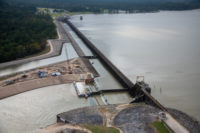Brazilian Dam Fix to Delay Opening Until Next Year
Lima, Peru � A Brazilian consortium constructing a dam in Southern Brazil has come up with a plan to repair the damage that led to a failure in the structure�s diversion tunnels that led to the draining of the facility�s reservoir in June.
The $523.9-million Campos Novos Dam was slated to go fully on-line this month but on June 20, two of three gates on a diversion tunnel built to divert the flow of the Canoas River failed. Officials now estimate more than 1 billion cubic meters of water from the reservoir flowed downstream and was captured by the reservoir for another recently built dam.
The dam is being built by the Campos Novos Supplier Consortium, CFCN, lead by Brazilian construction giant Camargo Corr�a along with Engevix Engenharia, CNEC Engenharia and GE-Hydro Inepar do Brasil. On July 17, CFCN submitted a proposal for the repairs to the independent consultants hired by the Brazilian Electricity Energy Agency. Early in August, officials from the consortium will present a more complete report to the government, officials said.
The problems may push the completion of the 880-Megawatt hydroelectric generating station possibly into early next year, said Jos� Ayres de Campos the engineering director for Camargo Corr�a. Ayers said the repairs should cost less than $5 million to complete but that estimates on the final cost of the delay, penalties from the contract and lost revenue has not been tallied yet. �The final surveys will likely include a number of different causes that lead to the leakage,� Ayers said.
One major reason for the leaks may have been large pieces of debris have striking the intake structure during the filling of the reservoir, Ayers said.
Currently, water from the Canoas River is being routed through one of two diversion tunnels. The company says that they will remove the diversion tunnel plugs in first tunnel to allow the water to be diverted through it while the second tunnel will be sealed with concrete plugs. Afterward, the gates on the first tunnel will be lowered to begin refilling the reservoir again. The work is expected to take the remainder of the year.
The consortium is also scheduled to present a plan to the agency in the next two weeks outlining the repairs to cracks that have appeared on the dam�s concrete face. Carmago officials said they expect that work to be completed within three months.
Ayers said the teams examining the dam for the consortium have not established a root cause for the cracks but the preliminary information indicates that the compaction of dam�s rock core allied with the increased rigidity of the concrete face was probably to blame. �The displacement of the material may have been larger than expected due to the shape of the dam,� he said.




